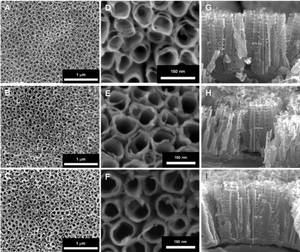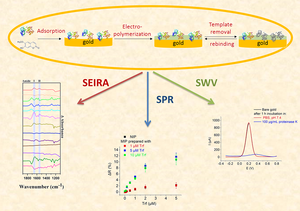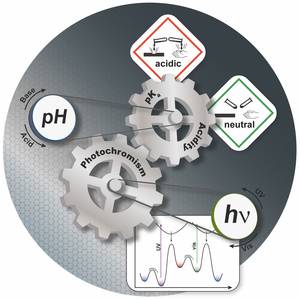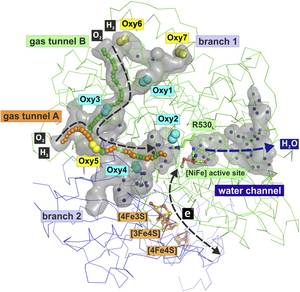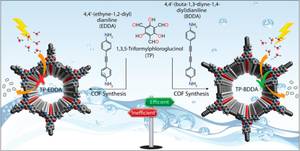Selected Research Highlights 2018
Electrografted interfaces on metal oxides for catalysis with highest stability
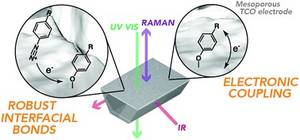
Tomos G. A. A. Harris, Robert Götz, Pierre Wrzolek, Victoria Davis, Caroline E. Knapp, Khoa Ly, Peter Hildebrandt, Matthias Schwalbe, Inez M. Weidinger, Ingo Zebger and Anna Fischer
Derivatized diazonium linkers were electrografted onto transparent conductive oxides as stable alternatives to conventional anchoring groups for the surface immobilisation of molecular species which are relevant as electrocatalysts or photosensitisers. The interface formation, structure and stability was investigated i.a. with surface sensitive in situ ATR-IR spectroscopy, in combination with (spectro)electrochemistry.
Thereby, an extraordinary stability was demonstrated in a wide pH range between 2.5 – 12 and a wide electrochemical potential window (-0.73 to 2.23 V vs. RHE in aqueous media). Furthermore, a high surface coverage was achieved with this electrografting approach for Fe porphyrin molecules active for the oxygen reduction reaction. Fast electron transfer and excellent electrochemical accessibility were demonstrated.
J. Mater. Chem. A, 2018, 6, 15200-15212 | DOI: 10.1039/C8TA02983K
High electromagnetic field enhancement of TiO2 nanotubes electrodes
Ibrahim Halil Öner, Christine Joy Querebillo, Christin David, Ulrich Gernert, Carsten Walter, Matthias Driess, Silke Leimkühler, Khoa Hoang Ly, Inez M. Weidinger
We present the fabrication of TiO2 nanotube electrodes with high biocompatibility and extraordinary spectroscopic properties. Intense surface enhanced resonance Raman signals of the heme unit of the redox enzyme Cytochrome b5 were observed upon covalent immobilization of the protein matrix to the TiO2 surface reflecting overall preserved structural integrity and redox behavior. The enhancement factor could be rationally controlled by varying the electrode annealing temperature with a record maximum value of over 70 at 475 °C. For the first time, such high values are reported for non-directly surface-interacting probes excluding an involvement of charge-transfer processes to be responsible for the signal amplification. The origin of the surface enhancement is exclusively attributed to enhanced localized electric fields resulting from the specific optical properties of the nanotubular geometry.
Angew. Chem. Int. Ed. 2018, 57, 1-6 | DOI: 10.1002/anie.201802597
Electrosynthesized MIPs for transferrin: Plastibodies or nano-filters?
Xiaorong Zhang, Aysu Yarman, Júlia Erdossy, Sagie Katz, Ingo Zebger, Katharina J. Jetzschmann, Zeynep Altintas, Ulla Wollenberger, Róbert E. Gyurcsányi, Frieder W. Scheller
Molecularly imprinted polymers (MIP) for transferrin (Trf) have been synthesized on gold surfaces by electro-polymerizing the functional monomer scopoletin in the presence of the protein target or around pre-adsorbed Trf. The target binding properties of the electro-synthesized MIP films was evaluated by square wave voltammetry (SWV) through the permeability changes of the MIP nanofilms to the ferricyanide redox marker, as well as by surface plasmon resonance (SPR) and surface enhanced infrared absorption spectroscopy (SEIRAS) of the immobilized protein molecules. For Trf a linear concentration dependence in the lower micromolar range and an imprinting factor of ~5 was obtained. Furthermore, non-target proteins including the iron-free apo-Trf were discriminated by pronounced size and shape specificity. We conclude that the interactions between the protein and the gold surface is involved in rebinding of the target.
Biosensors & Bioelectronics 2018, 105, 29-35 | DOI: 10.1016/j.bios.2018.01.011
published online ahead of print on January 9, 2018
Optimized Na2WO4/Mn/SiO2 catalysts for the oxidative coupling of methane
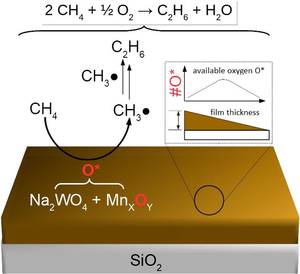
Vinzenz Fleischer, Ulla Simon, Samir Parishana, Maria Gracia Colmenares, Oliver Görke, Aleksander Gurlo, Wiebke Riedel, Lukas Thum, Johannes Schmidt, Thomas Risse, Klaus-Peter Dinse, Reinhard Schomäcker
The role of the composition of a Na2WO4/Mn/SiO2 catalyst in the oxidative coupling of methane by chemical looping experiments was investigated. The authors have analyzed a series of Na2WO4/Mn/SiO2catalysts supported on mesoporous silica. It was found that the chemical looping performance of the oxidative methane coupling strongly depends on the exact composition of the catalyst and was highest at 2 wt% Mn and 5 wt% Na2WO4 on mesoporous silica. The thickness of the active layer controls the O2 storage capacity of the catalysts, which was determined by repetitive methane pulse experiments.
Combined ESR, XRD and XPS experiments were used to show that the oxygen storage capacity is further correlated with manganese loading, which is in line with the reversible change of Mn(III) concentration observed in oxidation and reduction cycles of the material.
J. Catal. A, 2018, 360, 102-117 | DOI: 10.1016/j.jcat.2018.01.022 published online ahead of print Februar 22, 2018
Efficient Light-Induced pKa-Modulation coupled to Base-Catalyzed Photochromism
Johannes Gurke, Šimon Budzák, Bernd M. Schmidt, Denis Jacquemin, Stefan Hecht
Photoswitchable acid–base pairs, whose pKa values can be reversibly altered, are attractive molecular tools to control chemical and biological processes with light. A significant, light‐induced pKa change of three units in aqueous medium has been realized for two thermally stable states, which can be interconverted using UV and green light. The light‐induced pKa modulation is based on incorporating a 3‐H‐thiazol‐2‐one moiety into the framework of a diarylethene photoswitch, which loses the heteroaromatic stabilization of the negatively charged conjugate base upon photochemical ring closure, and hence becomes significantly less acidic. In addition, the efficiency of the photoreactions is drastically increased in the deprotonated state, giving rise to catalytically enhanced photochromism. It appears that protonation has a significant influence on the shape of the ground‐ and excited‐state potential energy surfaces, as indicated by quantum‐chemical calculations.
Angew. Chem. Int. Ed. 2018 | DOI: 10.1002/anie.201801270
published ahead of print March 23, 2018
Tracking the route of molecular oxygen in O2-tolerant membrane-bound [NiFe] hydrogenase
Jacqueline Kalms, Andrea Schmidt, Stefan Frielingsdorf, Tillmann Utesch, Guillaume Gotthard, David von Stetten, Peter van der Linden, Antoine Royant, Maria Andrea Mroginski, Philippe Carpentier, Oliver Lenz, Patrick Scheerer
Tracking the route of substrates, intermediates, and inhibitors in proteins is fundamental in understanding their specific function. However, following the route of gases like molecular oxygen within enzymes has always been challenging. In protein X-ray crystallography, gases can be mimicked using krypton or xenon (with a higher electron count); however, these have a different physical behavior compared to true substrates/inhibitors.
In our crystal structure of the O2-tolerant membrane-bound [NiFe] hydrogenase (MBH) from Ralstonia eutropha, we were able to show the direct path of molecular oxygen between the enzyme exterior and the active site with the “soak-and-freeze” derivatization method. This technique might be useful to detect O2 traveling routes in many other enzymes.
Proc. Natl. Acad. Sci. U.S.A. 2018 | DOI: 10.1073/pnas.1712267115
published ahead of print February 20, 2018
Diacetylene Functionalized Covalent Organic Framework (COF) for Photocatalytic Hydrogen Generation
Pradip Pachfule, Amitava Acharjya, Jérôme Roeser, Thomas Langenhahn, Michael Schwarze, Reinhard Schomäcker, Arne Thomas, Johannes Schmidt
Covalent organic frameworks (COFs) are crystalline, highly porous, two- or three-dimensional polymers with tunable topology and functionalities. Because of their higher chemical stabilities in comparison to their boron-linked counterparts, imine or β-ketoenamine linked COFs have been utilized for a broad range of applications, including gas storage, heterogeneous catalysis, energy storage devices, or proton-conductive membranes. Herein, we report the synthesis of highly porous and chemically stable acetylene (−C≡C−) and diacetylene (−C≡C–C≡C−) functionalized β-ketoenamine COFs, which have been applied as photocatalyst for hydrogen generation from water.
It is shown that the diacetylene moieties have a profound effect as the diacetylene-based COF largely outperforms the acetylene-based COF in terms of photocatalytic activity. As a combined effect of high porosity, easily accessible diacetylene (−C≡C–C≡C−) functionalities and considerable chemical stability, an efficient and recyclable heterogeneous photocatalytic hydrogen generation is achieved.
J. Am. Chem. Soc. 2018 | DOI: 10.1021/jacs.7b11255

